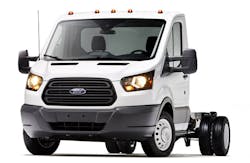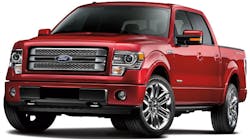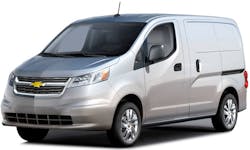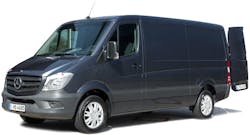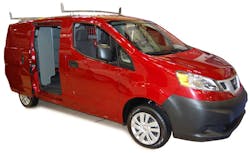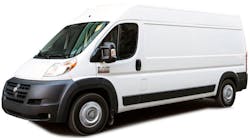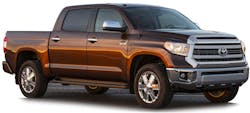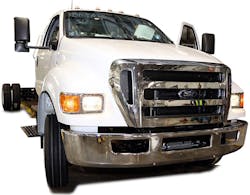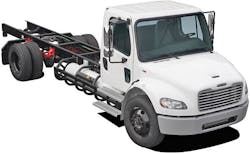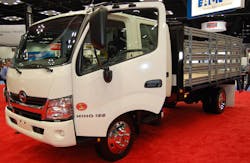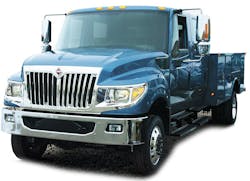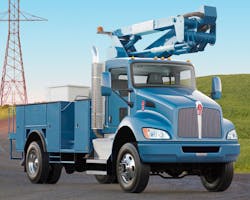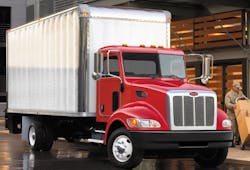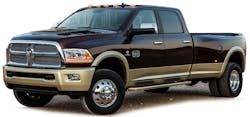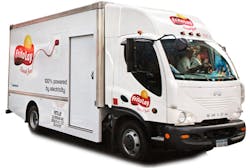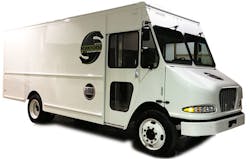While OEMs are offering altogether new models this year across the GVW spectrum, the biggest action is in the Class 1-3 segment. In this highly competitive arena, five nameplates are rolling out at least one new or thoroughly redesigned van or pickup model.
Light-duty debuts include the Ford Transit and the Ram ProMaster vans, as well as full redesigns of the Mercedes-Benz Sprinter and General Motors’ pickup stable mates, the Chevy Silverado and GMC Sierra.
Meanwhile, Class 4-7 truck builders are generally holding steady with their lineups and primarily announcing enhancements and options for their models. The biggest exceptions in the medium-duty segment are Ram’s higher weight ratings for its heavy-duty pickup and chassis-cab offerings along with word that Workhorse is looking to introduce an all-electric step van model.
The clearest trend spotted across the weight classes this year can be summed up in two words: more mpg. Truck makers are continuing their pursuit to boost fuel economy without impinging on key vehicle-performance metrics.
There are more fuel-sipping options than ever in the light end. The Ford Transit offers both a diesel and an EcoBoost gasoline engine. The gasoline engines in the Chevy Silverado and GMC Sierra boast cylinder deactivation to save fuel when less power is required. And both the Mercedes-Benz Sprinter and the Ram ProMaster offer integrated diesel engines and automatic transmissions to optimize fuel efficiency.
Medium-duty trucks offering fuel-efficiency enhancements include the International TerraStar with its Allison Optimized 1000 Series automatic gearbox and the optional roof fairings for the Kenworth T270 and T370.
Whether your operations run light- or medium-duty trucks, you’ll find this special section presents information on the newest models as well as other significant changes coming to North American trucks in the year ahead.
Light-Duty
Ford
The 2014 Transit full-size van Ford says will eventually replace its E-Series line is going to be offered with an optional 3.2L Power Stroke 5-cyl diesel engine, along with a 3.5L EcoBoost gasoline engine, among other options. Ford says all will be mated to a Ford 6R80 6-speed automatic transmission. Overall, the 2014 Transit will weigh about 200 lb less than the E-Series van and should provide up to a 25% improvement in fuel economy versus the E-Series line.
Chassis cab and cutaway models are also going to be offered. Len Deluca, director for the Ford Commercial Vehicles division, notes the new Transit chassis cab features an enclosed passenger compartment and bare frame ready to accept aftermarket body modules, ranging from custom cargo delivery to utility body. He says that while the Transit cutaway is similar to that of the chassis cab, the rear of the passenger compartment is open so it can be paired with specialty body modules, such as shuttle or school bus configurations. The chassis cab and cutaway will both be offered in three wheelbases (138 in., 156 in., or 178 in.) and GVWRs from 9,000 lb to 10,360 lb.
Ford also plans to provide a 3.7L V6 engine for the Transit with a CNG/LPG prep kit, as the OEM says more businesses and commercial customers are seeking relief from constantly fluctuating petroleum fuel prices. According to Ford, total CNG/LPG conversions typically run from $9,500 to $12,500, depending on fuel tank capacity. Depending on application and usage, Ford says businesses can see payback for CNG/LPG systems in as short as 24 months.
Ford is also redesigning its smaller Transit Connect van for the 2014 model year. One of 10 models based on Ford’s “C-1” global platform, it will be offered in two wheelbase sizes (105 in. and 212 in.), providing 105 cu ft and 130 cu ft of cargo storage room, respectively.
The standard engine for the Transit Connect will now be a 2.5L iVCT gasoline model that can be converted to run on CNG or propane; a 1.6L EcoBoost I4 gasoline engine is an option. The van also features a 6-speed automatic transmission versus the 4-speed in previous iterations.
Though Ford had completely redesigned its F-150 for the 2012 model year, followed by enhancements to the 2013 iteration, the OEM is reportedly now engaged in what’s being termed a “radical redesign” of the iconic pickup, which will incorporate a largely aluminum body to help increase fuel efficiency. Switching to the lighter metal in place of steel should cut the weight of the F-150 by some 700 lb — roughly a 15% reduction — to boost fuel economy while allowing for the use of smaller, yet more efficient engines.
General Motors
GM’s completely redesigned 2014 Chevrolet Silverado 1500 and GMC Sierra 1500 pickups are arguably more differentiated from each other in looks than their predecessor models. In addition, they both boast a new family of fuel-efficient yet powerful EcoTec3 gasoline engines. Dramatically styled exteriors and cabs are described as quieter as well as more comfortable and functional.
The GMC Sierra includes a new interior with two glove boxes, center console and door panel storage, and a six-gauge cluster. Four upfitter switches with 30A of power can switch between battery or ignition power as needed. The extended cab model has been eliminated in favor of a double cab, which includes forward opening rear doors.
The three available engine choices (4.3L V6, 5.3L V8, and 6.2L V8) offer increased power, torque, and fuel efficiency. The new engines feature direct fuel injection and continuously variable timing along with cylinder deactivation — switching down to four cylinders when maximum power is not required — to provide what the OEM dubs “maximum performance and minimum fuel consumption” in real-world conditions.
GM points out the manufacturer’s suggested retail price (MSRP) of the 2014 Chevy Silverado regular cab is equal to that of the 2013 Silverado model. The company adds that the base price includes several new features: the 5.3L EcoTec3 V8 engine, a 6-speed automatic transmission, an all-new cab interior, 4-wheel disc brakes with Duralife rotors, and a new bed with standard box rail protectors and “corner step” bumper.
The base MSRP for the 2014 Chevy Silverado 1500 double cab, which replaces the 2013 extended cab model and the crew cab models, will mirror the 2013 base MSRPs, GM notes. Fuel economy numbers for the 2014 Chevy Silverado are 16 mpg city, 23 mpg highway, and 19 mpg combined for its 2WD versions, and 16 mpg city, 22 mpg highway, and 18 mpg combined for 4WD models.
The OEM also plans to introduce small pickup models within two years to replace the discontinued Chevrolet Colorado and GMC Canyon. Those models were cut from the GM lineup in 2012.
GM also plans to introduce the Chevrolet City Express, a small cargo van, by the fall of 2014. It will be based on Nissan’s NV200 van but badged with the Chevrolet nameplate as part of a partnership deal between GM and Nissan, which the OEMs say should last several years. The City Express will use the Nissan powertrain, which includes a 2L 16-valve dual overhead cam 4-cyl engine rated at 131 hp and 139 lb-ft of torque. It will be available in two trim levels, the LS and LT, and feature 1,500 lb of payload capacity and 122.7 cu ft of cargo space. The van, which will be built in Cuernavaca, Mexico, was initially available only in cargo configuration.
Mercedes-Benz
A brand new iteration of the Mercedes-Benz Sprinter van is hitting the road for the 2014 model year, boasting a 4-cyl diesel engine, a 7-speed automatic transmission, five new safety systems, and improvements/refinements both to the interior and exterior of the vehicle.
The biggest upgrade comes in the form of fuel economy improvements due to the introduction of the 156-hp diesel engine in combination with the G-Tronic Plus automatic transmission. Mercedes-Benz executives say this pairing delivers an 18% improvement in fuel efficiency versus the previous 6-cyl diesel mated to a 5-speed automatic. An “Eco-Gear” 6-speed manual transmission is available.
The Sprinter is also available with supercharged 4-cyl gasoline engine featuring direct injection that cranks out 156 hp from a total displacement of 1.8L. The engine is available in a natural gas variant with the same performance.
Safety systems being offered on the Sprinter include crosswind assist, which helps steady the van during highway operation; collision prevention assist, which involves automatic braking; blind spot assist, which is radar-based to detect vehicles in driver blind spots; high beam assist, which automatically maintains highway illumination without blinding oncoming vehicles; and lane-keeping assist, which alerts the driver if the vehicle leaves its roadway lane.
Sprinter executives say that crosswind assist, which only activates once the vehicle exceeds roughly 50 mph, will come standard as part of the Sprinter’s electronic stability program system; the others will be offered as stand-alone options or as part of safety system packages. Ordering such technology as a complete package would cost roughly $1,780 MSRP, according to numbers given out by Mercedes-Benz officials.
The Sprinter also features a redesigned front grille and headlights along with other body style tweaks to help improve airflow around the vehicle. The chassis has been lowered to improve the van’s drag and fuel consumption profile while making it easier to load and unload cargo. New upholstery, a redesigned steering wheel, shift knob, instrument panel, and optional Becker map pilot navigation system round out the changes.
Nissan
The Nissan NV200 compact cargo van, introduced last year as a smaller sibling to the NV Cargo van and NV Passenger van, is designed to offer what the OEM dubs a “large cargo capacity with a small exterior footprint.” This will make it highly maneuverable in traffic or for negotiating city parking spaces.
Yet Nissan stresses its commercial platform allows for an estimated 1,500-lb maximum payload. The roomy cargo area allows for loading standard U.S. 40-in. × 48-in. pallets. Added utility is provided by the standard integrated mounting points, which allow installation of racks and shelves without drilling into the sidewalls.
The 2014 Nissan NV200 features a 2L 16-valve DOHC 4-cyl engine mated to an Xtronic CVT (continuously variable transmission) for smoother operation and responsive performance.
“The compact market is running maybe 40,000 units a year compared to 225,000 for big vans,” says Joe Castelli, vice president-commercial vehicles and fleet for Nissan North America. “But [the NV200] is a vehicle that can get 24 mpg city/highway combined. It won’t work for every operator, but if someone can get away with a 700-lb cargo capacity for their operation and thus can switch to a smaller yet more fuel-efficient cargo van, they will do it.”
For those needing a larger van, Nissan offers the NV Cargo van in three variations: the NV1500, NV2500, and NV3500. Nissan is also preparing to field what it calls an “all-new” model of its Titan full-size pickup, first introduced in 2003.
Pierre Loing, vice president – product and advanced planning and strategy for Nissan Americas, says that Nissan’s truck team is looking at broadening the Titan product portfolio to reach more personal-use buyers while also appealing to commercial owners and fleets.
www.nissancommercialvehicles.com
RAM
Several new efforts are in the works for Chrysler’s Ram Trucks division for the 2014 model year, including the rollout of a new diesel-powered version of its Ram 1500 half-ton pickup and a new commercial van dubbed the ProMaster, both of which will start production in the third quarter of this year.
Ram plans to introduce a 3L V6 version of its EcoDiesel engine mated to its 8-speed TorqueFlite automatic transmission in an effort to boost both fuel economy and low-end torque for its half-ton Ram 1500 pickup. The OEM expects an engine-transmission package will help reduce noise by 60%.
The Ram ProMaster full-size van is based on the Fiat Ducato van built for the European market. It is available in two roof heights (90 in. or 101 in.), three wheelbases, and four body lengths, with both chassis cab and cutaway model options. Its unibody frame architecture provides payload capacity of up to 5,145 lb and a maximum towing capacity up to 5,100 lb. The GCWR for the ProMaster is 11,500 lb when equipped with a 3.6L PentaStar V6 gasoline engine cranking out 280 hp and 260 lb-ft of torque mated to a 6-speed automatic. Customers can also spec the 174-hp 3L I-4 EcoDiesel, which generates 295 lb-ft of torque and is mated to a 6-speed manual for a GCWR of 12,500 lb.
The ProMaster also features a standard sliding door on the passenger side with an optional sliding door on the driver’s side. The sliding door openings are based on roof height: 49 in. × 60 in. for the low roof model and 49 in. × 70 in. for high roof models. In the rear, an available two-position rear clamshell door swings open up to 260°, folding almost flat to the side of the van. It also comes equipped with more than 35 active and passive safety features, with electronic stability control as a standard offering.
Ram also announced plans last month to introduce a small commercial van based on the Fiat Doblo. That vehicle, which has not been named yet, will debut in 18 to 24 months, according to the company.
Toyota
The 2014 model Toyota Tundra full-size pickup represents the first major change to the Japanese OEM’s U.S. pickup truck line since the launch of the current generation back in the 2007 model year, says Bill Fay, Toyota Division group vice president and general manager.
According to Fay, to satisfy the growing number of “premium” pickup buyers, the Tundra will come in five distinct grades — each of which will be immediately recognizable due to such design cues as a different front grille. He says the Tundra SR grade will remain its entry-level offering and is “designed primarily for the work-use buyer who will value its excellent utility on the job.”
The Tundra will be offered in three cab styles: 2-door regular cab, 4-door double cab, and 4-door CrewMax — all of which will be available either as 4×2 or 4×4 versions. Three engine offerings will also remain. A 4L dual overhead cam (DOHC) V6 will be standard on Tundra regular and double cab models and will produce 270 hp and 278 lb-ft peak torque. It will be paired with a 5-speed automatic transmission with uphill/downhill shift logic. The available 4.6L DOHC i-Force V8 will offer 310 hp and 327 lb-ft of peak torque while the 5.7L DOHC i-Force V8 will produce 381 hp and 401 lb-ft of peak torque, in both gasoline and Flex Fuel variants. Both V8s come standard with a 6-speed electronically controlled automatic transmission.
Fay says the Tundra’s 5.7L V8 will allow it to carry more than 2,000 lb and tow more than 10,000 lb. Other key features include front and rear bumpers that change from one to three pieces for lower replacement costs; a more ergonomic “driver-centric” cab that places the center stack 2.6 in. closer for easier access; and an added trailer brake controller for the towing package, with 4-pin and 7-pin trailer connectors that have been moved up next to the license plate to make them easier to use and less susceptible to damage.
Medium-Duty
Ford
A variety of upgrades were made to Ford’s F-Series Super Duty chassis for this year, including beefed up towing and payload capacities and improvements to its braking system. Those upgrades follow the introduction of a gasoline version of the F-650 Super Duty for the 2013 model year. The Ford Triton V10 gasoline-fueled engine is rated at 362 hp at 4,750 rpm and 457 lb-ft of torque at 3,250 rpm. It can also be configured to run on CNG and LNG.
The gas F-650 features the automatic transmission used in Super Duty models and will be available with or without a power take-off (PTO). The truck itself will be offered as either a ProLoader on 19.5-in. wheels or as a Dock Height model on 22.5-in. wheels. The gasoline-powered version is built as a straight truck only and carries a maximum GVW/GCW of 30,000/33,000 lb, and will only come with hydraulic brakes.
This year, Ford raised the conventional towing capacity of its F-Series Super Duty to 18,500 lb while boosting payload capability to 7,260 lb. These increases were largely due to the addition of bigger brakes to the vehicle, notes Michael Watkins, a Ford brake system engineer. The OEM increased what’s known as “brake rotor swept area” by 16.4% in the Super Duty’s front wheel brakes and by 14.5% in the rear in part to help dissipate heat, especially on long downhill grades.
Those changes also support a 700-lb increase in the maximum GVWR to 14,000 lb for the Super Duty, Watkins says. He also notes that Ford added a larger parking brake for its F-250 and F-350 models to help boost the maximum payload rating for both vehicles. Adding adjustable brake pedals also enhances customer comfort by personalizing the interface between driver and brake system.
Freightliner Trucks
Freightliner Trucks has not announced any major changes for its medium-duty lineup, which consists of its Business Class M2 106 and M2 112 models as well as its 108SD truck. The medium-heavy M2 106 lineup spans Class 5-8, with maximum GVW of 56,000 lb and engine ratings from 200 hp to 350 hp. M2 106 applications include pickup & delivery, fire & emergency, food & beverage, service & utility, refuse, dump, flatbed, towing, tanker, and sweeper trucks.
The M2 106 is offered in day cab, extended cab, and crew cab configurations. Available engines are the 6.7L Cummins ISB, rated at 200 hp to 325 hp and 520 lb-ft to 750 lb-ft of torque, and the 9L Cummins ISL, rated at 350 hp and 1,150 lb-ft to 1,300 lb-ft of torque. Available transmission options include a manual 6-speed Mercedes-Benz or Eaton Fuller in 5, 6, 8all, 9all, 9, and 10 speed; automated-manual 5- or 6-speed Eaton UltraShift; automatic Allison 1000, 2000, and 3000 models; and Eaton hybrids designated for city delivery, utility, and tractor.
According to the OEM, the M2 106 features a large cab with plenty of head and elbow room, lower cab height with wider and taller doors, and non-slip steps for easy entry/exit; an efficient dash and easy-to-reach automotive-style gauges and switches; standard tinted windshield glass that helps prevent glare for a better view of the road; a downward sloping aerodynamic hood that provides a clear, wide-open view of the road; and a low step-in height for easier entry/exit.
In addition, the M2 106 boasts up to 55° wheel cut, a set-back front axle, and a swept-back front fender and bumper that together “provide one of the industry’s tightest turning radius, improving wall-to-wall and curb-to-curb maneuverability, especially within neighborhoods.”
The Freightliner 108SD vocational truck comes in Class 7-8 ratings, with maximum GVW of 79,000 lb and engine ratings from 200 hp to 350 hp. Its listed applications are dump, refuse, utility, and sewer-vacuum trucks. The OEM notes the 108SD is engineered to “pack heavyweight power into a smaller package,” allowing it to both “take toughness onto tight job sites and down narrow streets.” The 108SD is offered in day cab, extended cab, and crew cab configurations.
Freightliner Custom Chassis Corp.
Expansion into specialty and niche markets is the watchword for Freightliner Custom Chassis Corp. (FCCC), with its latest partnership with ARBOC Specialty Vehicles, finalized in April of this year aimed at the co-development of a low-floor rear-engine custom chassis for paratransit fleets. Through the partnership, which started in the fall of 2012, FCCC and ARBOC Specialty Vehicles, a custom builder of paratransit vehicles for a variety of applications, are working to develop a customized, dedicated chassis for ARBOC’s “Spirit of Liberty” product line.
FCCC said the new product will be powered by a rear diesel pusher and features a low-floor design that eliminates the step-up over the rear axle, equipping the Spirit of Liberty line for its expected use in a variety of low-floor applications, such as assisted-living facilities, hotel and rental car transport, transit agencies, and others. The OEM adds that the chassis, available as a prototype only at this point, will offer customers a GVW of up to 25,900 lb while featuring ARBOC’s low-floor interior throughout the passenger area with no steps, and includes oversized wheelchair zones.
FCCC and ARBOC expect to have a second round of prototypes ready later this year or early 2014 before starting up production soon after full test validation. The Spirit of Liberty line will offer three models ranging in body length from 28 ft to 33 ft and seating capacity from 31 to 37.
The expansion into the paratransit market mirrors FCCC’s steps last year into the alternative fuel field, when it unveiled its S2G chassis with a factory-installed liquid propane gas (LPG) engine. Built on FCCC’s popular S2 chassis, the S2G’s 8L, 325-hp engine (supplied by Powertrain Integration) offers LPG technology using a General Motors long block engine and other components at its core. Designed for the medium-duty commercial market, the S2G chassis is suitable for pickup and delivery, student transportation, and municipal applications.
Like its diesel counterpart, the front-engine S2G uses the Freightliner M2 cab, which features a sloped, forward-tilting hood for superior visibility and easy engine access. It has a GVWR of 33,000 lb and comes equipped with an Allison 2300 automatic transmission with PTO provision.
Hino
The most recent upgrade to Hino Trucks’ Model 195 Class 5 medium-duty chassis is the inclusion of a double cab option. It is available on both the Model 195 and 195h Class 5 cabover trucks, which were introduced late last year. Available with a diesel (195) or diesel-electric hybrid (195h) powertrain, the 19,500-GVW Class 5 trucks feature 210 hp and 440 lb-ft of torque from Hino’s 5L J05E Series engine. The OEM says the option is a 4-door, 6-person double cab that can also be specified with a magnetic suspension.
“The double cab is an exciting addition to our expanding product line and a perfect fit for a wide range of applications such as landscape, towing, moving, storage, and construction,” notes Glenn Ellis, Hino’s vice president dealer operations, pointing out that the cab can accommodate drivers up to 6 ft, 6 in. tall.
Ellis adds that both the 195 and 195h Class 5 COE models feature an ergonomically friendly wide cab with a North American standard 33-in. frame rail width, a 56,900 lb per sq in. (PSI) frame, and a standard center-mounted rear fuel tank. The cab’s styling emphasizes aerodynamics and visibility with an angled windshield, narrow pillars, and rounded-radius curves, he says.
Hino’s first mobile application, which was released this year, provides customers personalized access to the OEM’s nationwide dealer network. This free app, available via the Apple Store and Google Play, offers a collection of useful tools for drivers, such as a dealer locator feature, access to HinoWatch roadside assistance, and a quick-reference specifications and warranty information guide.
Navistar International
Navistar International’s latest addition to its medium-duty lineup is the 4×4 version of its International TerraStar model, which it began shipping to customers this spring. The TerraStar was launched as a 4×2 truck in 2010 and is the medium-duty stable mate of the larger International DuraStar. According to the OEM, offering this 4×4 version opens the TerraStar up to the remaining lighter end of the medium-duty market, which the company says includes construction, utility, emergency, oilfield, and other vocational applications.
“The TerraStar is the smaller sibling to the DuraStar, leveraging the same platform and commercial-grade components,” says Navistar COO Jack Allen. “The TerraStar 4×4 will deliver additional commercial-duty capability for a wide range of customer needs, including construction, utility, landscape, and other off-highway applications.”
The TerraStar 4×4 is powered by a 300-hp, 6.8L International MaxxForce 7 V8 engine that delivers 660 lb-ft of torque. The engine is built using a compacted graphite iron block, which the OEM says offers high strength without added weight. Cummins SCR after treatment will be added to the engine by early 2014. A cab that is 30% wider than the competition offers 38% more visibility, says Navistar. The truck is available in extended cab or crew cab configurations and is constructed with double-sided, galvanized high-strength steel protected by a 5-step professional grade coating process to resist corrosion.
The TerraStar 4×4 also features the International Diamond Logic electrical system, which allows the engine, transmission, instrument panel, and other vehicle components to continually communicate with each other electronically. By monitoring critical vehicle functions and relaying information to the driver in real-time, Diamond Logic ensures safe, efficient vehicle operation, Navistar points out.
The truck’s Allison Optimized 1000 Series automatic transmission boasts “shift energy management,” load-based shift scheduling, and automatic “neutral” for simplified operations, the OEM notes. A Fabco TC-28 gear-driven transfer case is made of forged helical gearing and roller bearings to provide high torque and horsepower capacities while offering a quiet and smooth driving experience, says Navistar.
Other features of the TerraStar 4×4 truck include International’s Ride-Optimized Suspension (IROS) system; 138-in. and 150-in. cab-to-axle measurements with standard cab to accommodate 18-ft and 20-ft bodies; an aluminum step package and stainless steel fuel tank straps; “commercial-style” tiltaway hood that provides easy access to engine compartment for routine service and scheduled maintenance; 80,000-psi frame rails and huck-bolted frame for maximum strength; and a “commercial-grade” cab that the OEM says is designed to be more durable and able to resist cracking under heavy loads. Navistar adds that the TerraStar 4×4 is covered by a 5-yr/unlimited-mile warranty.
Isuzu
While not much is changing on Isuzu Commercial Truck of America’s medium-duty cabover trucks, the OEM is focusing on improving the parts, maintenance, and modification services that support its vehicles in the field.
First, the OEM continues to enhance its “FleetValue” line of fast moving and routine maintenance parts — oil filters, brake pads, rotors, belts, etc. — for the aftermarket, a line first rolled out five years ago. From an initial offering of four parts, FleetValue now offers 83 parts in total with the goal of offering 200 by the end of this year. Isuzu also continues to expand its PSMP, or priority service maintenance package, a dealer-based service where operators can “prepay” for basic maintenance services based on the yearly mileage nominally accumulated by their trucks.
The OEM also continues to enhance an effort launched last year via its dealership to more quickly convert or modify gasoline-powered NPR-HD (14,500-lb GVWR) trucks for alternative fuel operation. When placing orders for new trucks, Isuzu dealers can now select a “ship-thru” option to indicate that they have arranged to have the trucks modified at one of two independent centers near the OEM’s Charlotte, Mich., assembly plant. Following the modification, the center will return the trucks to Isuzu, which will then transport them to the dealers that ordered the units. This process eliminates unnecessary dealer-incurred transportation expenses and will shorten the amount of time necessary to obtain alternative fuel conversions and certain other types of modifications.
Isuzu also continues to work with Impco Technologies to finalize a bi-fuel propulsion package capable of operating on both gasoline and compressed natural gas. Isuzu says it has obtained certification from the Environmental Protection Agency for its bi-fuel conversion and is awaiting certification from the California Air Resources Board and the state of New York.
Kenworth
Kenworth Truck has announced several changes for its medium-duty Class 6 T270 and Class 7 T370 conventional cab models. The T270 and T370 models are now available with an optional aerodynamic roof fairing. The roof fairing is available for factory installation as a 2-piece model. It can also be installed at a Kenworth Truck dealership as a 1-piece version.
The OEM has also introduced a new heavy-duty front frame assembly option for the T370 truck that it says makes it easy for body builders to install customer winch bumpers. The new option includes durable austempered ductile iron cast front drive brackets, 3/8-in.-thick steel front adapters, enhanced radiator crossmember assembly brackets, C-channel front frame sections that can accept a winch bumper, and Ram Horn tow hooks for vehicle transport.
The bumper adapters can be used with other specialty bumpers commonly installed on utility, overhead automobile haulers, and fire/emergency vehicles, Kenworth points out. To order the heavy-duty front frame assembly, the T370 must be specified with front springs rated at a capacity of 13,200 lb or more. It may be ordered with either a front or non-front drive axle.
The other medium-duty trucks offered by Kenworth continue to be the Class 5 T170, Class 7 T440, and Class 7 T470 conventional-cab models as well as the Class 6 K270 and Class 7 K370 cabover models that were rolled out in 2012. Both the K270 and K370 are aimed at urban-delivery applications.
Mitsubishi Fuso
The 2014 model-year Fuso Canter FE and FG Series medium-duty trucks being rolled out by Mitsubishi Fuso Truck of America (MFTA) this year feature a longer 169.3-in. wheelbase for the Class 3 Canter FE125 and a side-mounted fuel tank as just some of the all new options available for these work trucks, according to Todd Bloom, MFTA’s president and CEO. There are also extended service intervals of 18,000 mi.
He says the longer wheelbase for the Canter FE125 model will allow the application of bodies up to 20 ft long in a truck that has a GVWR of 12,500 lb and a body/payload capacity of 7,095 lb, making it better suited for high-bulking applications like furniture delivery. The optional side-mounted fuel tank can replace the standard rear in-frame tank on any FE model with a wheelbase of 133.9 in. or longer for delivery trucks that require tuck-under lift gates or for rollback or stinger-type auto recovery applications.
“And while it may not seem like a major change, the addition of the Clarion AM/FM/CD radio, with its Bluetooth, MP3 and USB compatibility, recognizes a fact of life in our business: Most medium-duty work trucks are not driven by professional drivers,” says Bloom. “The Bluetooth capability ensures that drivers of our Canter models can communicate via cell phone unencumbered, offering convenience and permitting use in those areas in which hands-free operation is legislated.”
MFTA also says its new 2014 model-year Canters began meeting the new greenhouse gas fuel efficiency standards promulgated by the Environmental Protection Agency and Department of Transportation standards back in April, two years ahead of the regulatory compliance mandate.
Peterbilt
Peterbilt Motors has not announced any major changes for its medium-duty lineup. Spanning Class 5 to 7, this line continues to include the conventional cab Models 348, 337, 330, and 325 as well as the cabover Models 210 and 220. The OEM has made its extended day cab feature available on its medium-duty trucks. With this option, customers can expand the length of their day cab by an additional
10 in. and receive nearly 6 in. of added headroom.
The extended day cab, which was launched in 2011 on Peterbilt Class 8 truck models, is designed to increase a driver’s comfort and productivity. Both the driver and passenger seat recline is doubled to 23°, and there is 4 in. of added space between the steering wheel and the seat. In addition, 4 cu ft of built-in rear wall storage compartments have been added for equipment or paperwork.
Among the OEM’s most recent medium-duty updates is the expansion of powertrain options for Models 337 and 348 equipped with all-wheel drive to include the Paccar PX-8 engine. Optimized for these Class 7 models, the 8.3L 6-cyl is rated up to 350 hp and 1,000 lb-ft of torque, and provides increased throttle response and acceleration, notes the OEM.
The PX-8 offers two engine braking systems: A variable-geometry turbo provides standard engine braking up to 125 hp, and an optional compression brake delivers incremental braking horsepower. The all-wheel-drive versions of the Models 337 and 348 are also available with the Paccar PX-6 engine and either an Eaton Fuller manual or Allison automatic transmission.
The Model 337 is available in both truck and tractor configurations with GVW ratings of 26,000 lb to 35,000 lb, while the Model 348 can also be ordered either as a truck or tractor and offers GVW ratings of 35,000 lb to 66,000 lb, as well as “optional capacity ratings to suit almost any specialty vocation.”
RAM
Starting with the 2013 model year and continuing with the 2014 models, Ram boosted the weight ratings for its line of heavy-duty pickups and chassis cab trucks. The towing capacity of the Ram 2500 heavy-duty pickup is now 18,350 lb, with a GCWR resting at 25,000 lb. The Ram 3500 claims a 30,000-lb trailer capacity and 37,600-lb GCWR, thanks to a class-exclusive 50,000-lb PSI, high-strength steel frame; improved transfer case; higher load transmission; and upgraded 325-hp, 6.7L Cummins diesel engine cranking out 850 lb-ft of torque. The Ram chassis cab trucks (designated 5500 models) also got a boost in towing and GCWR capability to 29,600 lb and 37,500 lb, respectively.
A variety of features go along with the rating boosts, including a factory-integrated fifth wheel and gooseneck hitch mount; a 17,000-lb Class V hitch with 1,800 lb of torque weight; electronic stability control for dual-rear wheels; and a center high-mounted, stop light-positioned camera to provide a full view of the bed for easier hookup of fifth wheel or gooseneck trailers as well as cargo monitoring.
The company is also introducing an industry-exclusive Ram active air intake system that automatically draws cooler air from the front of the vehicle when it senses increased heat. This function also engages at high altitudes for better throttle response in low oxygen environments. When conditions are wet from snow, ice, or water-fording, the system pulls air from an underhood inlet.
To handle the beefed-up towing capability, a front and rear suspension system with advanced geometry builds upon the chassis improvements and greatly improves overall roll stiffness. An advanced 3-link front suspension on the Ram 3500 is necessary for the vehicle’s higher GVWR and for use with heavy front loads, including snow plows. Additionally, a Hotchkiss leaf spring rear suspension on the Ram 3500 offers improved ride and handling while helping deliver higher towing and payload capability.
Smith Electric Vehicles
Bryan Hansel, CEO of Smith Electric Vehicles, says that little change will be apparent right now on the company’s Newton Class 4-7 platform, currently offered in both a delivery truck and step-van configuration. However, a prototype is in the works to allow for the bi-directional flow of energy to and from the Newton’s battery system as part of the U.S. Deptartment of Defense contract to equip trucks with “vehicle-to-grid” capability. Hansel says that capability would allow off-duty trucks connected to the electrical grid for recharging to help “stabilize” electricity demand — and be paid by the hour to provide such service. “That could change the whole revenue-generating face of electric trucks in the medium-duty space,” he explains. “Having 10 Newton trucks in a fleet would mean the capability to offer 1MW of electrical storage, and utility companies would pay for that storage.”
Currently, Smith’s Class 4-7 Newton chassis is offered in three wheelbase options (154-in., 177-in., and 201-in. variants) with payload capacities ranging from 6,100 lb to 16,200 lb. The all-electric step-van model, built in unison with Utilimaster, offers a GVWR of 14,000 lb to 26,400 lb with a top speed of
55 mph range of 40 mi to 100 mi on a single charge, depending on how the vehicle is operated.
Hansel also related the status of Smith’s smaller-sized, all-electric Edison van model. The Edison is built around the European version of the Ford Transit chassis and features GVWRs of 7,700 lb to 10,100 lb and payload capacities of
1,600 lb to 5,100 lb. He said the Smith Class 3-4 model is in flux as Ford is moving to a new global-platform design for its vans and chassis cabs that will require a complete re-engineering of the electrical-propulsion package for the Edison.
Workhorse
The Workhorse medium-duty brand as well as patents and its Union City, Ind., assembly plant were purchased by Amp Holdings from Navistar International earlier this year via Amp Trucks, Inc., a newly formed subsidiary. The company plans to produce chassis, step vans, and other vehicle types for the North American medium-duty truck market. These will include Amp’s all-electric Workhorse chassis along with gasoline-, propane- and CNG-powered and hybrid units. At the time the sale was announced, the new owner said a specific timetable to reopen the Workhorse plant will be announced “as the transition occurs and order backlogs are established.” Amp Holdings is also the parent of Amp Electric Vehicles, founded in 2007, which manufactures electric-drive systems for Class 3-6 commercial truck platforms.
In May, the OEM said it will introduce an all-electric Workhorse step van model. Amp Trucks says the all-electric powertrain incorporates a dual-motor system that produces 250kW and “accelerates the 19,500-lb GVW vehicle faster than the original factory-installed diesel engine.” The system has a total energy storage system of 100kWh that “can push the 1,000-cu-ft vehicle 100 mi on a single charge.”
Accelerated durability testing of the all-electric van was completed at the independent Transportation Research Center (TRC). Amp says it engaged TRC “to simulate the rigors of package delivery in an environment where it is common to keep their vans in service for 20 years or more.” The accelerated durability testing ran for 4,000 mi during the Ohio winter from February to April. The comprehensive tests included running 2,000 mi at curb weight and 2,000 mi fully loaded. Each durability cycle was just under 10 mi long, and consisted of traversing a series of resonance, chatter, and impact bumps; a series of moderate washboards, frame twists, and dips; inverted chuckholes; stopping and starting on a 20% brake slope; “lock-to-lock” figure-8 maneuvers; a short slalom course; and traversing gravel roads.
According to the truck maker, the durability testing during the winter “demonstrates, on an accelerated time frame, the ability of Amp’s powertrain, battery management system, and related all-electric components to successfully withstand the rigors of operating under extremely demanding conditions while maintaining the structural integrity of the vehicle and Amp’s all-electric system.”
Amp noted that Workhorse will continue to offer its W42 and W62 commercial truck chassis. The W42 has GVW ratings of 12,000 lb to 14,500 lb, while the W62’s GVW ratings cover
19,500 lb to 23,500 lb. Engine options for both chassis consist of a choice of a 4.8L or 6.0L engine, with each powered either by gasoline, propane, or compressed natural gas.


